Page 390 - Weiss, Jernej, ur. 2019. Vloga nacionalnih opernih gledališč v 20. in 21. stoletju - The Role of National Opera Houses in the 20th and 21st Centuries. Koper/Ljubljana: Založba Univerze na Primorskem in Festival Ljubljana. Studia musicologica Labacensia, 3
P. 390
vloga nacionalnih opernih gledališč v 20. in 21. stoletju
ute opera is not about the characterization of the performers” but more
“the quickest possible course of events”43. The musical style naturally uses
a fairly simple idiom, with short melodies or melodic fragments and pre-
cise word-setting with very few repeated phrases. Osterc notes in his arti-
cle44 on the minute-opera that the idea arose in 1927, in the works of Hin-
demith, Toch and Milhaud, of which he is clearly familiar. He stressed that
in the minute opera the dramatic nature of the action should be limited and
the pathos removed.
Table 6: Osterc’s Minute Operas.
1930 Osterc Saloma The Bible
1930 Osterc Medea Euripides
1930 Osterc Dandin v vicah Molière and Hans Sachs
The parody opera Saloma (‘Salome’) of 1929-30 was the first, fol-
lowed by Medea and Dandin v vicah (‘Dandin in Purgatory’), both of 1930.
Dandin v vicah is described as “operna groteska”, while Saloma is called
“minutna opera-parodija”. As was frequently the case at the time, some top-
ics, those for Saloma and Medea, were taken from classical antiquity (see
Table 8), while Dandin was derived from Molière. Medea and Dandin v
vicah were first performed on 27 February 1932, both at the Ljubljana Op-
era House.45 There is no evidence for a performance of Saloma in the com-
poser’s lifetime.
Saloma in fact lasts a mere 11 minutes, using many of the features of
the instrumental music to dramatic effect.46 Particularly notable is the wry
and sardonic tone of the instrumental writing which supports the paro-
distic character of the story. Osterc is clearly mocking Strauss’s Salome,
the libretto for which was a German translation of Oscar Wilde’s powerful
original French-text play. In this opera, the dramatic events were careful-
ly planned: from the refusal of Jokanaan to Salome’s advances all the way
43 Cvetko, Osebnost skladatelja Slavka Osterca, 78.
44 Slavko Osterc, “Minutna opera,” Nove muzike, II. letnik, nr. 6, December 1929, 21.
45 Cvetko, Osebnost skladatelja Slavka Osterca, 79; Sivec, Dvesto let slovene opere, 37, 91.
46 Peter Andraschke, “Minutna opera »Saloma« Slavka Osterca – Die Minutenoper
»Salome« von Slavko Osterc,” Primož Kuret, ed., Slovenska glasba v preteklosti in
sedanjosti – Slowenische Musik in Vergangenheit und Gegenwart (Ljubljana: Kres,
1992), 204–215.
388
ute opera is not about the characterization of the performers” but more
“the quickest possible course of events”43. The musical style naturally uses
a fairly simple idiom, with short melodies or melodic fragments and pre-
cise word-setting with very few repeated phrases. Osterc notes in his arti-
cle44 on the minute-opera that the idea arose in 1927, in the works of Hin-
demith, Toch and Milhaud, of which he is clearly familiar. He stressed that
in the minute opera the dramatic nature of the action should be limited and
the pathos removed.
Table 6: Osterc’s Minute Operas.
1930 Osterc Saloma The Bible
1930 Osterc Medea Euripides
1930 Osterc Dandin v vicah Molière and Hans Sachs
The parody opera Saloma (‘Salome’) of 1929-30 was the first, fol-
lowed by Medea and Dandin v vicah (‘Dandin in Purgatory’), both of 1930.
Dandin v vicah is described as “operna groteska”, while Saloma is called
“minutna opera-parodija”. As was frequently the case at the time, some top-
ics, those for Saloma and Medea, were taken from classical antiquity (see
Table 8), while Dandin was derived from Molière. Medea and Dandin v
vicah were first performed on 27 February 1932, both at the Ljubljana Op-
era House.45 There is no evidence for a performance of Saloma in the com-
poser’s lifetime.
Saloma in fact lasts a mere 11 minutes, using many of the features of
the instrumental music to dramatic effect.46 Particularly notable is the wry
and sardonic tone of the instrumental writing which supports the paro-
distic character of the story. Osterc is clearly mocking Strauss’s Salome,
the libretto for which was a German translation of Oscar Wilde’s powerful
original French-text play. In this opera, the dramatic events were careful-
ly planned: from the refusal of Jokanaan to Salome’s advances all the way
43 Cvetko, Osebnost skladatelja Slavka Osterca, 78.
44 Slavko Osterc, “Minutna opera,” Nove muzike, II. letnik, nr. 6, December 1929, 21.
45 Cvetko, Osebnost skladatelja Slavka Osterca, 79; Sivec, Dvesto let slovene opere, 37, 91.
46 Peter Andraschke, “Minutna opera »Saloma« Slavka Osterca – Die Minutenoper
»Salome« von Slavko Osterc,” Primož Kuret, ed., Slovenska glasba v preteklosti in
sedanjosti – Slowenische Musik in Vergangenheit und Gegenwart (Ljubljana: Kres,
1992), 204–215.
388


